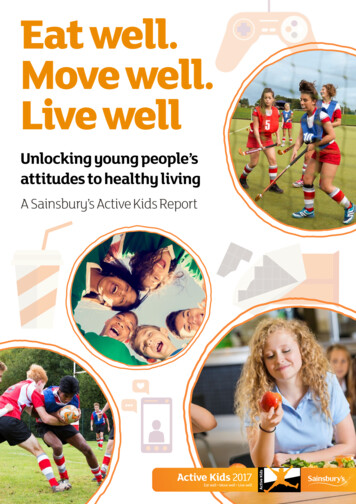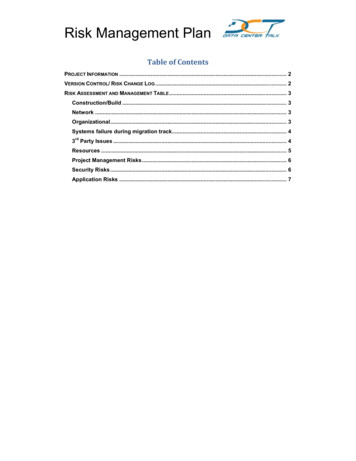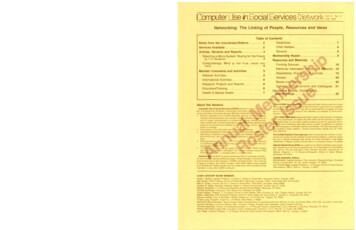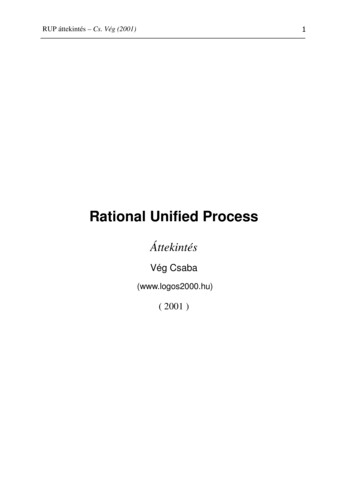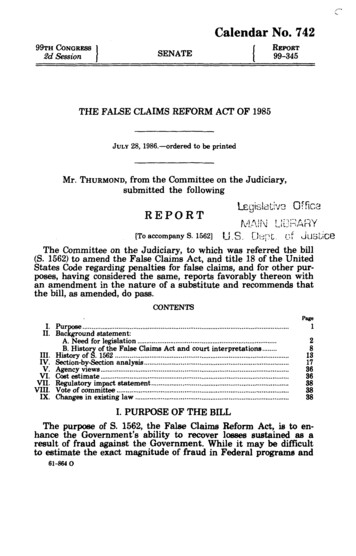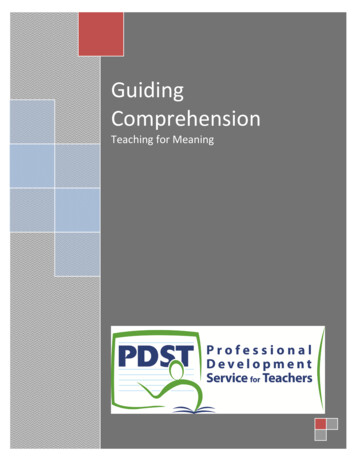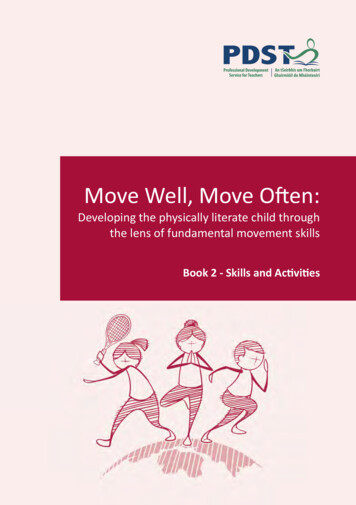
Transcription
Move Well, Move O en:Developing the physically literate child throughthe lens of fundamental movement skillsBook 2 - Skills and Ac vi es1
This resource has been designed by members of the Professional DevelopmentService for Teachers. Its sole purpose is to enhance teaching and learning in Irishprimary schools and will be mediated to prac sing teachers in the professionaldevelopment se ng. Therea er it will be available as a free downloadable resourceon pdst.ie/publica ons and scoilnet.ie/pdst/physlit for use in the classroom. Thisresource is strictly the intellectual property of PDST and it is not intended that it bemade commercially available through publishers. All ideas, sugges ons and ac vi esremain the intellectual property of the authors (all ideas and ac vi es that weresourced elsewhere and are not those of the authors are acknowledged throughoutthe resource).It is not permi ed to use this resource for any purpose other than as a resource toenhance teaching and learning.Any queries related to its usage should be emailed to: info@pdst.ie PDST 2017This work is made available under the terms of the Crea ve Commons A ribu on Share Alike3.0 Licence h p://crea vecommons.org/licenses/bysa/3.0/ie/.You may use and re-use this material (not including images and logos) free of charge in anyformat or medium, under the terms of the Crea ve Commons A ribu on Share Alike Licence.Please cite as: PDST, Move Well, Move O en: Developing the physically literate child throughthe lens of fundamental movement skills. Book 2 - Skills and Ac vi es, PE Curriculum, Dublin,2017.2
ContentsIntroduc onpage004Locomotor Skills007page 019page 033page 047page 061page 081page Side steppingStability Skills109page 123BalancingpageLandingManipula ve SkillsStriking with an implement137page 151page 165page 179page 193IndexpageCatchingpageThrowingKickingStriking with the hand3207
IntroductionThis resource is intended to contribute to the development of the physicallyliterate child. It has been designed to complement the teaching of the IrishPrimary School Physical Educa on (PE) Curriculum and aims to provide a range oftools to support the teacher in teaching fundamental movement skills (FMS)throughout the primary school. These experiences should lead to a physicallyliterate pupil, who has the movement competence, confidence, andunderstanding to con nue par cipa on in physical ac vity throughout their lives(Whitehead, 2016).It is not intended that the development of FMS replaces the Physical Educa on(PE) lesson. Rather, it is intended that this skill development is integrated into thePE lesson in line with the overall school plan. In this way, the teacher focuses alens on skill development within a lesson that is based on one of the strands ofthe PE curriculum. It is suggested that the teacher introduces a maximum of twoteaching points per skill during each PE lesson.This is an interac ve resource comprising a teacher guide, three teacher resourcebooks and supplementary online material. Each book outlines teaching andlearning approaches for fi een FMS.For more detailed teacher guidance please refer to the 'TeacherGuide' accompanying this book. Access to this resource andaddi onal ac vi es are also available online atwww.scoilnet.ie/pdst/physlitEach teacher resource book outlines teaching and learning approaches for thefollowing fundamental movement skills (FMS):Locomotor SkillsStability SkillsManipula ve SkillsTranspor ng the body in any Balancing the body indirec on from one point to s llness and in mo onanotherControl of objects usingvarious body parts Walking Running Hopping Skipping Jumping for height Jumping for distance Dodging Side stepping Catching Throwing Kicking Striking with the hand Striking with animplement Balancing Landing4
The ac vi es that are outlined to develop and consolidate these skills aredifferen ated across the three books. For example, the ac vi es in Book 1 aregenerally aligned to the infant classes, the ac vi es in Book 2 are generallyaligned to the junior/middle classes, the ac vi es in Book 3 are generally alignedto middle/senior classes.It is important to teach a balanced range of locomotor, stability and manipula veskills across the year.Schools should select the number of skills for development in any given year, inaccordance with pupils' needs and aligned with the school plan.Within each ac vity the teacher will be provided with: Equipment - a list of the equipment needed for the ac vity. Descrip on - how to set up and play the ac vity. Varia ons - sugges ons for differen a on.Key Words - vocabulary associated with the skill.Téarmaí as Gaeilge -foclóir a úsáid go neamh oirmiúil i rith an cheacht.Tips - organisa onal and safety ps to maximise learning.Take Home - an op onal ac vity to reinforce learning outside of the PE lesson.In recording their learning in a PE journal, pupils can reflect on and consolidatetheir learning, in addi on to documen ng their physical literacy journey.The following icons are used in the ac vity descrip ons to outline opportuni esfor linkage across PE strands.This resource is intended to be available to the whole school community. It isrecommended to keep these resources in a common sharing area where all staffmembers have access to them. This resource and addi onal support materials areavailable online at www.scoilnet.ie/pdst/physlit.5
6
WalkingSiúlWalking is the most basic oflocomotor skills, it involves thetransfer of weight from one foot toanother while moving eitherforwards or backwards. A key featureof walking is the absence of a flightphase with one foot in contact withthe ground at all mes. As probablythe most used fundamentalmovement skill, walking appears inevery facet of everyday life. Walkingto school, recovering between moreintensive movements in game situa ons, recrea onal ac vi es, and moving fromone room to another at home are all examples of the need for proficient walkingtechnique.Things to considerWalking technique is o en taken for granted, however, it is an importantprecursor to other fundamental movement skills and should be given adequatea en on.Walking, weight transfer, posture, movement, locomotor skill,arm swingSiúl aistriú meáchain iompar an choirp gluaiseachtscil ghluaiseachta luascadh láimhe7L
IDENTIFYING THE STAGES OF DEVELOPMENTExploring StageTréimhse taisceálaíochtaAGE 5At this stage, pupils prac se the skill of walking through explora on andexperimenta on. Characteris cs of walking at the exploring stage: bouncy or uneven walking ac on arms tend to swing excessively and are held out from the body to help balance feet are too close or too far apart toes tend to be turned either in or out head is too far forward.Developing stageTréimhse forbraíochtaAGE5-6At this stage, pupils prac se walking at different speeds, levels and direc ons ontheir own and with others. Characteris cs of walking at the developing stage: walking pa ern is more even arms swing in opposi on to the legs but are s ll a li le s ff stride length is inconsistent posture is s ll incorrect, with head falling forward and body not straight.Mastering stageTréimhse MáistritheAGE7 At this stage, pupils should be able to master the skill of walking. Walking withrhythm and efficiency should be evident and applied in a variety of contexts.Characteris cs of walking at the mastering stage: walking ac on is smooth and even good posture is evident with head up and body straight arms swing naturally in coordina on with opposite leg toes face forward and stride length is consistent.Walking8
TEACHING POINTS FOR WALKINGMaintain good posturewith body straight, walktall, head in line withthe spine andlooking forwardArms swing in a smallnatural arc in opposi onto the feetStep with toesfacing forwardKnees should bendslightly when the footmakes contact withthe groundWhen plan ng the footuse a heel-to-toe ac on9Walking
THE MOVEMENT INSPECTORIntroducing the skill of walkingTry to walk Effec ve ques ons forwardsWhat are your eyes looking at? backwardsHow are you looking where youare going? sideways without moving your handsWhat are your hands used for? without bending your kneesHow much should yourknees bend? tall like a giraffe small like a mouseWhich is be er, how tall shouldyou be? on your toes only on your heels onlyWhat feels comfortable, can youuse both? in slow mo on as fast as you can without runningWhat happens to technique? like a robot along a line in a circle with correct techniqueLet's put it all together!This teacher-led exercise encourages guided discovery and allowspupils to iden fy the correct technique. Effec ve ques oning can helpto guide pupils in their learning.Walking10
TEACHER OBSERVATIONCommon errors and feedbackCommon Errors Éarráid Choi antaFeedback AiseolasLooking down when walkingHead up, walk tallLe arm swings with le leg and viceversaOpposite ac ons, right arm swings withyour le leg and le arm swings withyour right legBall of the foot making first contactwith the groundWalk using a rolling ac on from heel totoeWalking RubricExploringDevelopingMasteringLegs Feet are too closeor too far apart Toes tend to beturned either in orout Stride length isinconsistent Toes face forwardand stride length isconsistentArms Arms tend to swing Arms swing inexcessively and areopposi on to theheld out from thelegs but are s ll abody to helpli le s ffbalance Arms swingnaturally incoordina on withopposite legAc on Bouncy or unevenwalking ac on Walking pa ern ismore even Walking ac on issmooth and evenHead Head is too farforward Posture is s ll Good posture isincorrect, with head evident with headfalling forward andup and bodybody not straightstraight11Walking
FOLLOW THE LEADER - ROCK, PAPER, SCISSORSDescrip on of Ac vityOn a signal, pupils begin walking within the playing area. All pupils should beencouraged to walk in a random direc on. When they meet another pupil face toface they stop and play rock, paper, scissors with them. The winner becomes aleader and the loser now follows their new leader. The process repeats betweenleaders, stopping to play rock, paper, scissors. Whichever leader loses, their en regroup must join the back of the winning group. This process con nues un l theen re class is following along behind one pupil or leader.Varia ons Vary the locomotor skill used to move around the area, e.g.skipping, hopping or side stepping.EquipmentAn open playingarea Discourage pupils from touching or pushing, take no ce of the movementpa ern of the pupil in front. In your PE journal, draw a picture of you walking in a crowded place.comhartha siúl bealaí éagsúla aghaidh ar aghaidh carraig páipéar siosúr ceannaireWalking12
ELEPHANT WALKDescrip on of Ac vityPupils line up in single file facing the same direc on. Establish a finish line in theplaying area for the elephant walk. Pupils take the shape of an elephant with theirright hand ac ng as the trunk in front of their body and the le hand throughtheir legs as the tail. Invite pupils to hold the tail of the elephant in front of themwith their trunk to create one con nuous line. The group then advances forwardas a line of elephants.Varia ons Invite pupils to manoeuvre around obstacles and swerve theline of elephants as they move. Prac se in smaller groups, then join the elephants together.EquipmentAn open playingarea Encourage pupils to work together as a group. Encourage pupils to watch the pupil in front of them as their guide. Pause the ac vity at intervals to focus on the teaching points for walkingin the lesson. Invite a pupil to demonstrate correct technique, allow pupilsto prac se in isola on and then return to the ac vity. Provide feedback toindividuals while they perform the walking ac on during the ac vity. In your PE journal, draw a picture of the Elephant Walk ac vity.dalta i ndiaidh an dalta eile ceann scríbe bolb crom síos breith ar rúi ní deas clé13Walking
SPEED UP/SLOW DOWNDescrip on of Ac vityArrange pupils in groups of four and invite one pupil to act as the pace se er. Therole of the pace se er is to change pace from very slow, to medium, to fast andback again. The rest of the group follow the pace established by the pace se er.Change the pace se er frequently giving each pupil a chance to be in thatposi on.Varia ons Change direc on, e.g. walking on a windy path. Vary the locomotor skill used to move around the area, e.g.skipping or side stepping. Vary the height or level of walking (on ptoes or bent overwith head up).EquipmentAn open playingarea with clearboundary lines No touching or grabbing and allow a safe space from the pupil in front. Ensure pupils keep their head up so they don't collide with other pupils. Play this game in the yard with your friends.i mbeirteanna reathaí ceann riain an mhall go méanach go tapa seans do gach páisteWalking14
OVER UNDERDescrip on of Ac vityWhen travelling to another loca on in the school, invite pupils to walk in single filewith the front pupil holding a ball. The leader passes it to the pupil behind bypassing the ball over their head. The next pupil will pass the ball under their legsto the pupil behind. This pa ern of over and under con nues un l the ballreaches the end. The pupil at the end must walk quickly all the way to the front ofthe line to start the ac vity again.Remember, the rest of the group is s ll walking the en re me, so the pupil at theback has to move quickly.Varia ons Vary the way the ball is passed back to the next pupil byrota ng the body to the right or the le .EquipmentA ball Ensure pupils' path is obstacle free. Encourage pupils to call out the word 'over' or 'under' as they are passingthe ball so the next pupil is aware of the move they should make. Ensure that pupils are always aware of where the ball is. Also ensurepupils at the back have enough space to walk past the other pupils. Pause the ac vity at intervals to focus on the teaching points for walkingin the lesson. Invite a pupil to demonstrate correct technique, allow pupilsto prac se in isola on and then return to the ac vity. Provide feedback toindividuals while they perform the walking ac on during the ac vity. In your PE journal, write down a fun and safe walking ac vity we cancomplete as a class to move from one area of the school to the other.áit eile dalta i ndiaidh an dalta eile liathróid a chuir siar thar do cheann idir do chosa ceannaire dalta ar chúl siúl15Walking
I SPYDescrip on of Ac vitySome sugges ons include: If you meet a teacher, complete five jumping jacks. If you see a bird in the sky, spin in a circle and then con nue on. Start skipping if you see a flower. If you see a black car, reach to the sky and then touch your toes beforecon nuing. High-five someone near you if you see a white van.Varia ons Invite pupils to complete these challenges in pairs. They canwork together to spot certain objects, or different challengescan be set to involve partner work.EquipmentAn open playingarea Invite pupils to make up new rules giving them ownership of the ac vity. Ensure pupils all know to stay close to the group. Pause the ac vity at intervals to focus on the teaching points for walkingin the lesson. Invite a pupil to demonstrate correct technique, allow pupilsto prac se in isola on and then return to the ac vity. Provide feedback toindividuals while they perform the walking ac on during the ac vity. Play this game at home. Perform similar ac ons for par cular cues, e.g.when you see a family member, complete five star jumps, and when youhear a phone ringing, walk forwards three steps etc.ag siúl ceann scríbe rialacha comhartha stop éan sa spéir scipeáil carr veainWalking16
SWITCH, CHANGE, ROTATEDescrip on of Ac vityArrange pupils in groups of three around the playing area. Each group lines up insingle file facing the same direc on. There are three commands in the ac vity. Switch - The lead pupil and the back pupil change places. Change - The en re group turns around and goes the opposite direc on. Rotate - The lead pupil goes to the back and the centre pupil becomes thenew leader.To begin the ac vity each group marches on the spot and a empts to execute thecommands called out by the teacher.Varia ons From marching on the spot progress to walking, running orhopping. Allow the pupil in the middle of each line to give thecommands. Invite groups to compete against each other to see who cancomplete a series of commands the quickest.EquipmentAn open playingarea Discourage pupils from distrac ng other pupils. Play this game in the yard with your friends.grúpaí de thriúr dalta i ndiaidh an dalta eile aistrigh athraigh rothlaigh ag mairseáil treoracha an mhúinteora17Walking
18
RunningRithRunning is a similar ac on to walkingexcept there is a moment ofsuspension called the flight phasewhen both feet are simultaneouslyoff the ground. Momentum isachieved when force is created bythe back leg driving off the ground.The greater the force created andapplied in a given direc on, thefaster the run will be. The skill ofrunning includes jogging, sprin ng,dodging and evading. The ability torun is essen al to perform a widerange of ac vi es in both everydaylife and spor ng contexts. Whether itis sprin ng in a race or running forpleasure, chasing a football or tryingto catch a bu erfly, it is essen al thateveryone develops a proficient running technique.Things to considerWhen prac sing running ensure that ac vi es are done in an open playing area. Ifan enclosed area is used, then make sure that there is adequate space betweenpupils and also a large enough runoff safety area to allow pupils the opportunityto slow down and stop.Running, flight phase, momentum, leg drive, safety, L-shaped arms,accelera ng, high knee li , stride lengthRith tréimhse ei lte móiminteam brúigh coise sábháilteacht brostú ardú glúine fad abhóige19L
IDENTIFYING THE STAGES OF DEVELOPMENTExploring StageTréimhse taisceálaíochtaAGE 5At this stage, pupils enjoy exploring different speeds of running, in a variety ofdirec ons and on various levels. Characteris cs of running at the exploring stage: knee li and kick back is limited arm swing is wild and away from the body, with 90 degrees not beingmaintained at the elbow no obvious flight phase head is unstable.Developing stageTréimhse forbraíochtaAGE5-6At this stage, pupils prac se running efficiently at different speeds in differentdirec ons. The skill is applied to a variety of mini games and ac vi es.Characteris cs of running at the developing stage: knee li is higher but not yet parallel. Back leg is extended to push off and givemore momentum arm swing increases, is closer to the body and is more in tune with legmovement limited flight phase.Mastering stageTréimhse MáistritheAGE7 At this stage, pupils are running with efficient technique and applying the skill in avariety of contexts such as, running for a sustained period of me, sprin ng,engaging in dodging and evading ac vi es and applying the skill naturally in aspor ng context. Characteris cs of running at the mastering stage: stride is a good length, arms and legs are in rhythm and head is stable high knee li and leg kickback is evident obvious flight phase feet land along a narrow pathway.Running20
TEACHING POINTS FOR RUNNINGHold the head up,stable and eyeslooking forwardElbows bent at90 degreesDrive arms backwardsand forwards vigorouslyin opposi on to the legs.Ensure arms stay close tothe body, 90 degree angleremains at the elbow andthe drive comes from theshouldersHigh knee li with thethigh almost parallel tothe ground21Running
TEACHING POINTS FOR RUNNINGPush off from the ball ofthe foot and land on theheel of the foot ini ally,however, when the runspeed increases contactwill be madepredominantly with theball of the foot onlyThe kick back should beclose to the bu ocks (atleast 90 degrees)Lean slightly forwardwhen accelera ng andslightly backwards whenslowing downRunning22
THE MOVEMENT INSPECTORIntroducing the skill of runningTry to run Effec ve ques ons tall like a giraffe without bendingyour kneesWhat posi on should your bodybe in? small like a pixie bent over at the waist without moving your armsTry to make an L with your arms is it possible? looking at the sky/looking at the groundWhere should you look? on your ptoes/flat footedHow should you land/take off? forwards/backwardsIf running backwards lookover shoulder as fast as you can on the spotWhat are arms and knees doing? along a different path to everyone else for as long as you canWhat happens to technique whenyou - get red or get compe ve? as fast as you can in front of/behind a partner holding hands using all the correct technique outlinedLet's put it all together!This teacher-led exercise encourages guided discovery and allowspupils to iden fy the correct technique. Effec ve ques oning can helpto guide pupils in their learning.23Running
TEACHER OBSERVATIONCommon errors and feedbackCommon Errors Éarráid Choi antaFeedback AiseolasEyes looking down or head movingfrom side to sideHead up, look forward, no wobbly headmovementsExcessive rota on of the trunkEnsure your chest is facing forward,breaking the finish line tapeArms swinging wildly out from, oracross the bodyKeep your arms L-shaped, close to yourbody, pump backwards and forwardsNot li ing the knee high enoughresul ng in a shortened strideEncourage longer strides, ‘knee up,extend your foot out, down’Leaning too far forward when runningRun tall, head up, chest outEyes looking at the ground or feetHead up, eyes forwardLegs too far apart and flat footedRun a narrow pathway, follow animaginary lineRunning RubricExploringDevelopingMasteringLegs Knee li and kickback is limited Knee li is higherbut not yet parallel Back leg isextended to pushoff and give moremomentum Stride is a goodlength High knee li andleg kickback isevident Feet land along anarrow pathwayArms Arm swing is wildand away from thebody, with 90degrees not beingmaintained at theelbow Arm swingincreases, is closerto the body and ismore in tune withleg movement Arms and legs arein rhythmFlight No obvious flightphase Limited flight phase Obvious flightphaseHead Head is unstable Head is stableRunning24
FRUIT BASKETDescrip on of Ac vityArrange pupils in groups of five with a hoop per group. Invite groups to place theirhoops around the perimeter of a large outdoor playing area, equidistant from acentral point. Lay as many small, light pieces of PE equipment as possible in thecentre of the playing area (fruit salad). On a signal, one pupil from each groupruns to the fruit salad, picks up one piece of fruit and carries it back to their hoop.This process is repeated un l all pieces of fruit have been gathered. The groupwith the most pieces of fruit in their hoop wins.Varia ons To prolong the ac vity allow pupils to steal pieces of fruitfrom each others hoops for a given me period. Freeze theac vity and count how much fruit is in each hoop. Use cones to make a large square around each hoop as a nogo zone. Pupils must throw the fruit into the hoop fromoutside the square, thus focusing on throwing accuracy. Pupils must jump over three items of fruit before they canpick one up.EquipmentAn open playingarea, beanbags,foam balls,hoops, cones Ensure there is adequate space to throw and pick up beanbags so as tominimise collisions. Play the ac vity in reverse to save work se ng up a er an ac vity so thatthe first group to get all their pieces of fruit back in the salad wins. Pause the ac vity at intervals to focus on the specific teaching points forrunning in the lesson. Invite a pupil to demonstrate correct technique,allow pupils to prac se in isola on and then return to the ac vity. Providefeedback to individuals while they perform the running ac on during theac vity. Play a game that involves running every day this week in the yard.fonsaí ciseán torthaí thit na torthaí amach torthaí a phiocadh suas glaoigh amach ainm an toraidh ag obair le chéile25Running
CORNER RELAYDescrip on of Ac vityArrange pupils in groups of five. Use cones to set out a large outdoor squareplaying area with a pupil from each group at each corner. There should be twopupils at the first corner. On a signal, one pupil from each group in the first cornerjogs slowly to the next corner, tags their teammate and stays in that corner. Assoon as they have been tagged, that pupil jogs slowly to the next corner and soon. The ac vity con nues un l the fi h pupil tags the first pupil, who begins thenext round by jogging faster. With each new round, the speed is increased slightly,going from a slow jog, to a faster jog, to running and eventually sprin ng.Varia ons Vary the locomotor skill used to move around the area, e.g.skipping, hopping, or side stepping. To adapt this into a cool-down ac vity, reverse the sequenceso that the first lap is at a running pace and the last lap is awalking pace.EquipmentAn open playingarea, cones Remind pupils to move safely and to avoid colliding with each other at thecorners. While wai ng for their turn, pupils can perform ac vi es, e.g. run on thespot, roll their shoulders, hips and ankles or do gentle stretches. In your PE journal, list three reasons why it is important to warm upbefore doing an ac vity.cóin cearnóg coirnéal ag siúl luas níos tapúla bogshodar rithRunning26
THE QUEEN'S JEWELSDescrip on of Ac vityArrange pupils in groups of four. Use cones to set out a star ng point for eachgroup. Place a hoop beside each cone. Sca er or hide the Queen's Jewels aroundthe playground. Ensure there are more jewels than pupils. On a signal, the firstpupil in each group runs out into the playing area trying to find a jewel as quicklyas possible. Each pupil can onlybring back one jewel at a me.When they retrieve a jewel, theyplace it in the hoop at theirgroup's base. The next pupil in thegroup repeats the process. A er aset amount of me, iden fy whichgroup has collected the mostamount of jewels.Varia ons Set a me limit. Repeat the ac vity to see if thegroup can beat their record by collec ng thejewels in an even faster me. Allocate a specific coloured jewel to each group. If the playing area is limited, arrange pupils intofour or five groups, allowing only one pupil fromeach group to run at any me.EquipmentAn open playing area,cones, hoops, crownjewels - small shiny nonvaluable objects(plas cine wrapped inkitchen foil would work,invite pupils to help youmake them) Remind pupils to move safely and to avoid colliding with each other,making sure they keep their head up and look forward when running. Pause the ac vity at intervals to focus on the specific teaching points forrunning in the lesson. Invite a pupil to demonstrate correct technique,allow pupils to prac se in isola on and then return to the ac vity. Providefeedback to individuals while they perform the running ac on during theac vity. Invite a grown-up to help you to make the jewels, and recreate thisac vity at home.seoda an bhanríon seoda a aimsiú ceann amháin ag an am sa chiseán ag an am céanna27Running
ROCK, PAPER, SCISSORS TAGDescrip on of Ac vityArrange pupils in pairs, standing one metre apart and facing each other. All pairsline up along a centre line with a safety line posi oned twenty metres behind bothsets of pupils. Each pair begins by performing a rock-paper-scissors rou ne. A rockis a closed fist, paper is a flat hand, and scissors are the index and middle fingers ina cu ng posi on. Paper always covers rock, rock breaks scissors, and scissors cutpaper. To determine a winner, pupils count to three and form a rock, paper, orscissors. The winning pupil then chases their partner toward their safety line,a emp ng to tag them before they are safe. Line up again and repeat the ac vity.Varia ons Use whole body rock, paper, scissors movements instead.Rock is a crouched body posi on. Paper is a standing, armsstretched up posi on. Scissors is an arms outstretched tothe side posi on. Begin from a seated on the floor posi on.EquipmentAn open playingarea, cones,spot markers Vary the locomotor skill used to move, e.g. skipping,hopping. For safety purposes ensure pupils run in a straight line to the safety lines. Ensure there are no hazards on the ground and posi on safety lines atleast five metres from any walls or boundaries to allow a sufficientdistance to slow down. Play this game in the yard.carraig páipéar siosúr cluiche tóraíochta líne sábháilteachta pointeRunning28
NUMBER RUNDescrip on of Ac vityInvite pupils to sit or hunch in a large circle. Number pupils one to six around thecircle, star ng at one again at the seventh pupil. Leave one beanbag in the centreof the circle. When the teacher calls out a number, all pupils with that numberstand up and run clockwise around the circle. When they arrive back to theirstar ng places, they must run through the gap into the circle and try to pick up thebeanbag.Varia ons Arrange pupils into smaller groups of twelve with pupilsnumbered one to four. Whoever wins the previous roundcalls the number for the next round to keep the ac vitygoing. Remove the beanbag element to make the ac vity lesscompe ve. Place a pile of beanbags in the centre of the circle. When apupil retrieves a beanbag, they bring it back to their placeand the group with the most beanbags at the end wins.EquipmentAn open playingarea, beanbags Remind pupils to move safely and to avoid colliding with each other,making sure they keep their head up and eyes forward when they run. Introduce balancing. When wai ng for their turn pupils can performvarious balances. Inves gate how many seconds it takes you to run around the outside ofyour house. Invite a family member to me you.suite i gciorcal uimhir málaí pónairí deiseal29Running
TAILSDescrip o
Book 2 - Skills and Acvies, PE Curriculum, Dublin, 2017. 3 . Introducon page 004 Locomotor Skills Walking page 007 Running page 019 Hopping page 033 Skipping page 047 Jumping page 061 Dodging page 081 Side stepping page 095 . scissors with them. The winner becomes a leader and the loser
